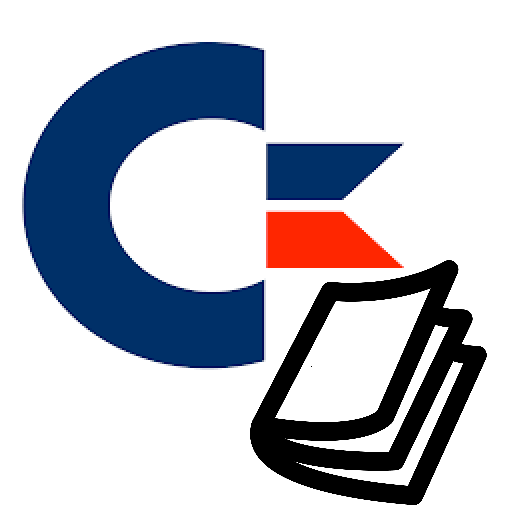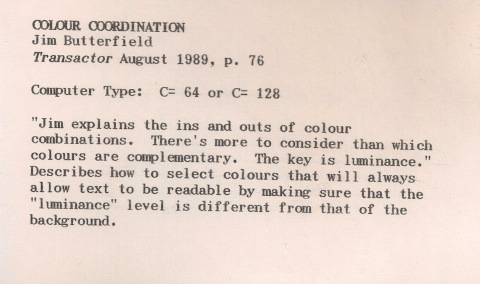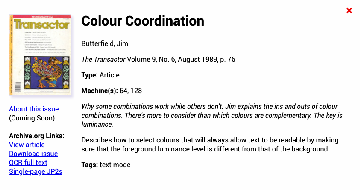The Commodore 8-Bit Magazine Index

The Commodore 8-Bit Magazine Index is a detailed catalogue of the articles published in 8-bit Commodore-specific print magazines. There are currently 6,399 articles catalogued in the index from a wide variety of publications including Compute!'s Gazette, RUN, Commodore World, and many others.
I've put this landing page here to serve as a "permalink"; the index is currently hosted on Heroku, but that may change at any time. If you link to the index, and wish to safeguard against linkrot, please link to this page and not the index application itself.
I gave a presentation about this project at the 2023 World of Commodore expo in Mississauga, Ontario.
The Story of the Index
Dr. Myles L. Skinner
I first learned to program in BASIC on the Commodore PET in 1981—my parents had the foresight to sign me up for a night class at a local high school. Computers were the future and I remember that there was some societal anxiety about being left behind. I was the youngest in the class but not by a lot; quite a few kids got their introduction to microcomputers in that class. In 1981, the VIC-20 was already out on the market but I wouldn't have known that. For the first two years of my programming life, the green monochrome PET was the only computer I knew.
I didn't have a computer at home until 1983, when I received the budget-friendly Timex-Sinclair 1000 (also known as the ZX-81) as a Christmas gift. The apartment building where we lived was a United Nations of home computers: friends across the hall had a VIC-20, another friend downstairs had an Atari 800, and the family across from him had a TI-99/4A. We all had the chance to play around with a variety of machines in the early '80s. There were never any arguments about which computer was "superior"—each one was different, and all of them were cool. But when our school acquired the new Commodore 64, I knew what I had to save up my paper route money for.
Over the years, I spent a lot of time programming and studying. I didn't own any books or magazines, so the public library was the most useful resource I had available. I can remember reading and re-reading back issues of Compute! and Compute!'s Gazette many times. Over time, the Amiga, Macintosh, and PC began to take over library shelf space, and 8-bit resources were harder and harder to find. I used to travel to out-of-town universities and public libraries, reading back issues on microfilm and photocopying from what few books I could still find in the stacks.

Building a Personal Library
When Commodore announced bankruptcy in 1994, I felt compelled to begin preserving all the 64-related books and magazines I could find. I scoured used book stores, library sales, and local BBSes hoping to "rescue" print material. I even made Greyhound bus trips to neighbouring cities where I negotiated deals for dusty stacks of magazines in strangers' garages. I enjoyed a lot of success, too—we once had a friendly bragging competition on the Usenet newsfroup comp.sys.cbm and it was determined that I had the most complete library on Usenet, and possibly one of the most complete libraries in the world. I'm sure my holdings have since been surpassed—in fact, I wouldn't be surprised to learn that there were bigger collections at the time, but it's fair to say that I have a lot of books and magazines.
Such a huge cache of reference material begs to be organized, and I began printing up index cards and filing them in little boxes to build a card catalogue that would help me find interesting articles again after I head read them. I didn't get very far, because maintaining a physical card catalogue large enough to index my entire library would have entailed a ludicrous amount of work.
Going Digital
In 1994 I was not able to forsee that nearly three decades later in 2022, there would be massive document repositories on the internet, housing digital copies of the books and magazines I had been working so hard to track down. (One of the best of these archives is at bombjack.org.) Approaching the complete collection is overwhelming—with so much reference material, it's often hard for a researcher to know where to begin looking for information on any topic of interest.
These days, I make my living as a Senior Developer, and my preferred framework is Ruby on Rails. A Rails app seemed like the ideal platform for bringing my old card catalogue online. The base application took about a month to develop, working part-time on evenings and weekends. Getting data into its database is taking much longer, and I still have a lot of work ahead of me. The index application and its database are hosted on Heroku, which isn't cheap but is an expense I'm willing to bear in order to make the index available as a public service.
The index application has a few neat features. If you find a magazine article you are interested in, you can pull up a detailed description that includes a picture of the magazine's cover and a direct link to the article hosted on archive.org.

Enlarged Image
Archives, Libraries, and Museums
As I've built my online card catalogue, I've given a lot of thought as to what my role should be. (A side-effect of a lifetime spent in academia is that you indulge in a fair bit of introspection when you should be doing actual work.)
Am I an archivist? I think the ideal archive strives to be complete; an archivist attempts to include everything. There are already some excellent archives online—I've already mentioned Bombjack, but you can also visit The Internet Archive and numerous smaller, more focused archives on the 'net. I don't think I'd be contributing much of value were I to create another archive that simply duplicates what is already out there.
Maybe I'm a librarian? After all, my index is a bit like an old-school card catalogue. But good librarians do a few things that I won't. Librarians are good at matching users with materials to suit their needs; pairing books with readers is an art in itself. More importantly, librarians make decisions about what materials to include, and what materials to cull to keep a collection fresh. I'm not good at letting things go; I don't think I'd be a very good librarian.
Instead, I think I may actually be a curator. I imagine the magazine archives as a big museum. There may be some public-facing exhibits dotted around the web, but the whole collection is locked away somewhere in a storage room in the basement. The curator's job is to provide entry points, to help researchers make sense of all the materials that are locked away. You can disagree with my distinctions among archives, libraries, and museums—and you probably should! The boundaries are not so clear, and there is a lot of overlap between categories. I prefer to think of myself as the curator of the Commodore 8-Bit Magazine Index, and whether you think that's a good job title or not, I invite you to take a tour of my museum and sample the exhibits.
As a parting thought, I'll leave you with the advice Fred D'Ignazio left in his final Gazette postscript: "Don't throw your beautiful old computers away. I'm sure you can dream up at least one more creative way to keep using them." (Gazette Disk, February 1995). I hope my index will help you find those creative ways.
Dr. Myles L. Skinner is the “curator” of the CBM 8-Bit Magazine Index.
